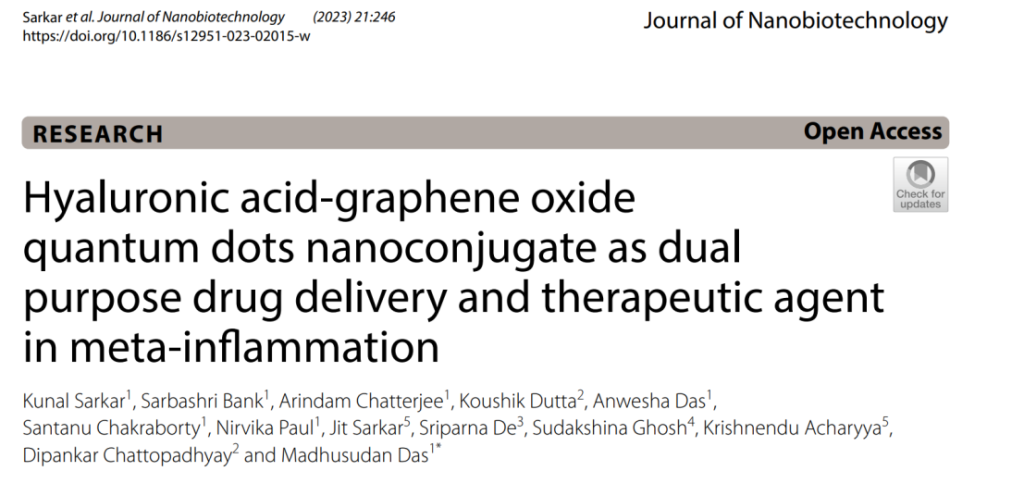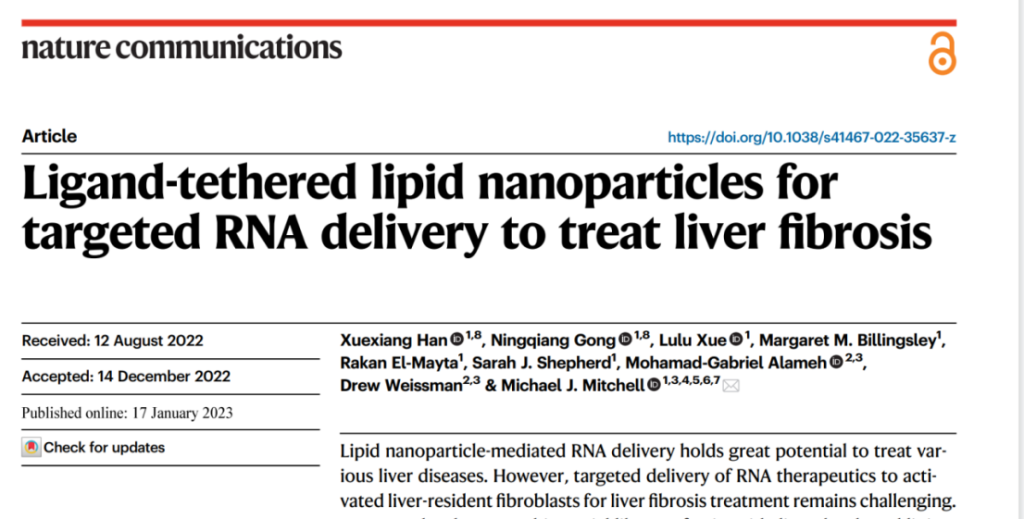Introduction
Nanoparticle drug targeting strategies have significantly advanced in recent years, offering more efficient and precise therapeutic options compared to traditional drug delivery systems. These advancements in nanomedicine have focused on improving targeting accuracy, biocompatibility, and immune escape, as well as enabling controlled drug release, combination therapies, and personalized treatments. Unlike conventional methods, nanoparticles can be engineered to target specific disease sites, reducing systemic toxicity and improving therapeutic outcomes. This article highlights the latest developments in nanoparticle drug targeting strategies, focusing on their ability to address the challenges of traditional treatments, enhance drug delivery efficiency, and offer personalized therapeutic solutions for complex diseases.
1. Hyaluronic Acid-Graphene Oxide Quantum Dots Nanoconjugate for Targeted Metformin Delivery

In the study Hyaluronic acid-graphene oxide quantum dots nanoconjugate as dual-purpose drug delivery and therapeutic agent in meta-inflammation by Kunal Sarkar et al., published in Journal of Nanobiotechnology, the researchers present a targeted metformin delivery system using a hyaluronic acid-functionalized graphene oxide quantum dot (GOQD-HA) nanoconjugate. This innovative strategy improves the targeting accuracy by focusing on macrophages, which are key mediators of inflammation in diseases like Type 2 Diabetes Mellitus (T2DM) and non-alcoholic steatohepatitis (NASH). By attaching hyaluronic acid (HA), a ligand that targets the CD44 receptor overexpressed in inflamed tissues, the nanocarrier not only delivers the drug but also enhances its therapeutic effect through the intrinsic antioxidant and anti-inflammatory properties of the graphene oxide quantum dots. This dual-functional approach showcases a promising advancement in targeting accuracy and drug release control, as the GOQD-HA system specifically delivers metformin to sites of inflammation, improving the drug’s efficacy while minimizing side effects. This development marks a key step in personalized treatment for inflammatory diseases, where targeting specific molecular markers can tailor the therapy to individual patient needs.
2. Ligand-Tethered Lipid Nanoparticles for Targeted RNA Delivery to Treat Liver Fibrosis

Xuexiang Han and his team explored the use of ligand-tethered lipid nanoparticles (LNPs) for targeted RNA delivery to treat liver fibrosis in their paper Ligand-tethered lipid nanoparticles for targeted RNA delivery to treat liver fibrosis published in Nature Communications. The researchers used anisamide-tethered lipidoids (AA-lipidoids) to target activated hepatic stellate cells (HSCs), which play a central role in fibrosis progression. This study emphasizes biocompatibility and immune escape, as the AA-lipidoid nanoparticles avoid immune detection while efficiently targeting the fibrotic liver. The team demonstrated that AA-T3A-C12, a lead lipidoid, achieved targeted delivery and silencing of heat shock protein 47 (HSP47), a key protein involved in collagen production. The resulting reduction in liver fibrosis and collagen deposition highlights the potential of LNPs not only for liver disease therapy but also for combination therapies, where RNA-based treatments can be combined with traditional drug therapies for enhanced efficacy. The ability to specifically target activated fibroblasts opens new avenues for personalized treatment, especially for patients with advanced liver fibrosis, where tailored therapies can address the unique pathophysiological conditions.
3. L-lysine Functionalized Mesoporous Silica Hybrid Nanoparticles for pH-Responsive Drug Delivery

Madhappan Santhamoorthy and colleagues developed a pH-responsive drug delivery system using L-lysine-functionalized mesoporous silica nanoparticles (MS@Lys NPs) for curcumin delivery in their paper L-lysine Functionalized Mesoporous Silica Hybrid Nanoparticles for pH-Responsive Delivery of Curcumin published in Pharmaceutics. Mesoporous silica nanoparticles (MSNs) were modified with L-lysine to enhance the drug loading capacity and facilitate drug release control under acidic conditions found in tumors. The L-lysine groups, which feature both amine and carboxyl groups, enable the MS@Lys NPs to bind tightly to curcumin in a neutral pH environment, releasing it under more acidic conditions, typical of tumor sites. This system highlights biocompatibility and targeting accuracy, as the modified nanoparticles are stable under physiological conditions yet responsive to the tumor’s acidic microenvironment, allowing for controlled drug release. The study demonstrates a potential therapeutic strategy where combination therapy could be used by integrating curcumin’s anti-inflammatory properties with other cancer treatments, making it a versatile addition to the arsenal of personalized treatments for cancer patients.
4. Superparamagnetic Iron-Oxide Nanoparticles for Breast Cancer Treatment

In the paper Superparamagnetic Iron-Oxide Nanoparticles Synthesized via Green Chemistry for the Potential Treatment of Breast Cancer, Neha Tyagi and collaborators investigate the use of superparamagnetic iron-oxide nanoparticles (SPIONs) as drug delivery carriers for tamoxifen (TMX) in breast cancer therapy. Published in Molecules, the study explores how SPIONs, when coated with bovine serum albumin (BSA), can enhance the stability of the nanoparticles and target specific cancer sites through magnetic guidance. The incorporation of TMX, a drug commonly used for estrogen-positive breast cancer, into the SPIONs allows for targeted drug delivery and reduces the adverse effects associated with conventional chemotherapy. This approach demonstrates the importance of biocompatibility and immune escape, as the BSA coating prevents aggregation and ensures that the nanoparticles remain stable in the bloodstream. The ability of SPIONs to deliver drugs directly to tumor cells, along with their magnetic properties for precise targeting, offers a promising strategy for combination therapies in cancer treatment. This strategy holds great potential for personalized treatment in breast cancer, as therapies can be tailored to target specific tumor types and reduce systemic toxicity.
Conclusion
The recent advancements in nanoparticle drug targeting strategies discussed in these studies highlight key innovations in targeting accuracy, biocompatibility, immune escape, drug release control, combination therapies, and personalized treatment. Each study demonstrates how nanoparticles can be engineered to address the limitations of traditional treatments, offering more effective and precise therapeutic solutions. These strategies not only enhance drug delivery but also reduce side effects, paving the way for safer, more effective treatments for a range of diseases, including cancer, metabolic disorders, and chronic inflammation. As these technologies continue to evolve, they promise to transform the landscape of medicine, offering patients treatments that are tailored to their unique biological conditions.
References:
- Han, Xuexiang, et al. “Ligand-tethered lipid nanoparticles for targeted RNA delivery to treat liver fibrosis.” Nature communications 14.1 (2023): 75.
- Sarkar, Kunal, et al. “Hyaluronic acid-graphene oxide quantum dots nanoconjugate as dual purpose drug delivery and therapeutic agent in meta-inflammation.” Journal of Nanobiotechnology 21.1 (2023): 246.
- Santhamoorthy, Madhappan, et al. “L-Lysine functionalized mesoporous silica hybrid nanoparticles for pH-responsive delivery of curcumin.” Pharmaceutics 15.6 (2023): 1631.
- Tyagi, Neha, et al. “Superparamagnetic iron-oxide nanoparticles synthesized via green chemistry for the potential treatment of breast cancer.” Molecules 28.5 (2023): 2343.
